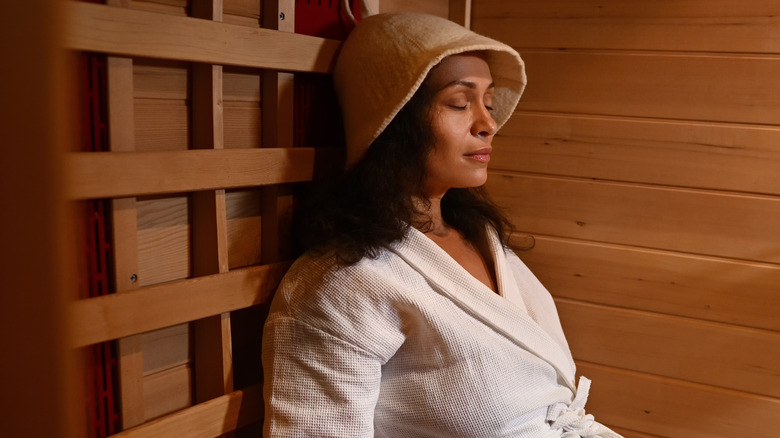What To Know Before You Try An Infrared Sauna
Sauna, which means "bath house" in Finnish, is a term used to describe any heating system designed to boost sweating, per Saunas.org. The sauna has been a well-liked dry bathing method in Europe for centuries, and it's now practiced in many parts of the world. In countries such as Japan, China, and South Korea, sauna bathing has become an essential relaxation ritual. The reason why sauna is so popular is that it encourages heavy perspiration, which is associated with numerous health benefits. A survey published in the journal Complementary Therapies in Medicine polling 482 participants found that nearly a third of respondents with muscular pain and mental issues reported significant improvements in their conditions after sauna-bathing once to twice per week.
Spending time in an enclosed, wood-line room heated between 70 degrees and 93 degrees Celsius raises your skin temperature to roughly 40 degrees Celsius. Strong heat sensations make you sweat profusely, which helps cool down your body, buffer muscle strains, and release mood-boosting endorphins. Sauna bathing is also found to lower blood pressure, boost heart health, and help you burn calories. Compared to over 2,000 years ago, the heating system used in sauna bathing has evolved significantly, with the infrared sauna being the most widely used modern iteration of the traditional sauna. If you want to bio-hack your body, do not preclude sauna bathing from your daily self-care routine. Here's everything you need to know before entering an infrared sauna.
Infrared sauna vs traditional sauna
Before getting into the benefits of an infrared sauna, it's important to understand the fundamental differences between this modern kind of sauna and a regular sauna. In a traditional sauna, people would sit in a log cabin structure around a fire pit with rocks laid over the top. Then, bathers would throw water on the rocks to create abundant steam and trigger a blast of humidity. Meanwhile, infrared saunas employ cutting-edge infrared heaters that mimic the same infrared wavelengths created by the sun to warm your body directly without warming the room first, per Clearlight Saunas.
Because they concentrate on heating the body directly rather than the space, infrared saunas are usually cooler, with room temperature usually between 48 degrees and 51 degrees Celsius. For those enjoying a deep, invigorating heat blast experience but having difficulty sitting through the intense heat of a traditional sauna, infrared is an excellent alternative. Rimba Sweat claims that infrared saunas, which take 10 to 15 minutes to warm up, allow you to sweat more intensely compared to traditional saunas because infrared heat penetrates the skin more effectively than warm air. Both traditional and infrared saunas are suitable for at-home installations, with infrared saunas being more affordable, low-maintenance, and energy-efficient.
Precautions to keep in mind
When using an infrared sauna, there are some safety rules to keep in mind. Per My Sauna World, a quick exercise before sauna bathing to get your blood pumping will help loosen up your muscles more easily. Because sauna bathing will dehydrate you, drink 16 to 20 ounces of water and stay away from the booze before a session. You should also take a speedy shower to rinse your body of excess sweat or dirt. When inside a sauna, gently brush your skin with a sauna whisk to stimulate pore opening and blood circulation. Stash away your phone during the session because the high temperature can damage its internal components.
A usual sauna session lasts between 15 and 20 minutes or 10 to 15 minutes with occasional cool-down intervals in between, depending on your tolerance. Two to five minutes after a sauna, you can take a final shower to refresh yourself. Then, drink sufficient water and wear loose clothes to keep yourself comfortable. If you have trouble sleeping, an early evening sauna can buffer the strain and prepare your body and mind for sleep, notes Andy Kaps, the president of manufacturer Clearlight Infrared (via Nutritious Life). On the other hand, an early morning sauna can perk you up and equip you with enough energy to confront the remainder of the day. If you have a heart, blood, or skin condition, it's recommended to seek advice from your healthcare provider before using a sauna.


